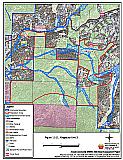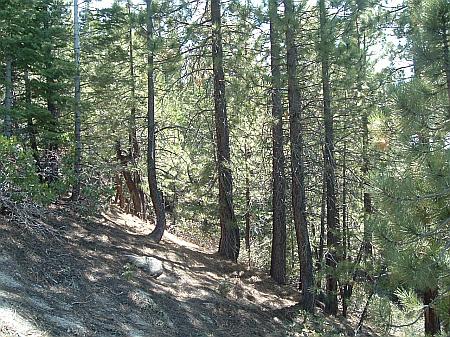Risk/Hazard Identification and Mitigation Project Worksheet
Name of Community: Kingsbury
Date: July, 2004
Project Title: Kingsbury Unit 3 - Thinning and Brush Removal
Description of Risk/Hazard: Describe in detail the risk or hazard that poses a threat to the community.
Vegetative Fuel and Topography: The Kingsbury Unit 3 prescription area is characterized by a dense forest stand of Jeffrey pine, with a brush understory of manzanita and other associated shrubs. Open areas are dense fields of brush. Stand density varies from 60 square feet of basal area per acre to 300 square feet of basal area per acre. Part of the prescription area has slopes over 30%.
Worst Case Scenario / Hazard: A human-caused ignition on a high hazard day with wind blowing upslope off the lake would push an uncontrollable fire up the Edgewood Creek drainage and into Kingsbury neighborhoods. The Gondola Fire in 2003 exhibited similar behavior.
Priority Ranking: What is the priority ranking of this risk/hazard in relation to all others identified?
Because of large expanses of fuels below and upwind of the community, this project ranks as #2 priority for the TDFPD.
Location: Describe or attach a map with sufficient detail to allow accurate ground location.
South of State Route 207 in the Edgewood Creek drainage. See Figure 11-11 for details
Recommended Mitigation Measures and Scope of Work: Present prescription and work specifications in sufficient detail to facilitate procurement of bids and quotes. For hazardous fuel removal projects include estimated volumes (tons/acre) of fuel removed and disposal plan.
Remove or thin brush understory to lower fire intensity and reduce ladder fuels. Remove dead and down material. Spacing between remaining bushes should be 2-3 times the height of brush. Remove brush and smaller trees from underneath residual trees to a distance of 10 feet. A brush masticator or “Bull Hog” could be used where slopes are less than 30%. Aerial systems or other steep slope methods should be explored on area greater than 30%. Hand cut, pile, and burn. Use of herbicide could reduce sprouting of some species.
Thin forest stand from below, removing smaller trees and leaving larger ones to achieve the desired stocking rate of 80 to 100 square feet of basal area per acre. Where dominant trees are left, prune limbs to 15 feet above the ground and maintain a minimum tree spacing of 10 to 20 feet between crowns. Remove trees heavily infected with dwarf mistletoe or other disease.
*Prescribed fire could be used to reduce the brush understory, and desired where feasible to return fire to the landscape. It should only be applied in areas after thinning and slash pile burning are complete to maintain fire control.
Evaluation of the Extent to Which Completion of This Project Will Reduce the Fire Threat:
Treatment in this area will help contain human-caused ignitions below the project area, keeping fire spreading uphill towards a residential development and becoming uncontrollable. This treatment will be the best defense against a fire in the lower Kingsbury neighborhoods moving into the upper neighborhoods. This treatment will be necessary if suppression resources are to be effective in stopping such a fire. Implementation of the prescription will reduce the competition among residual trees, increasing forest health and decreasing tree mortality. This will reduce the accumulated amount of dead and down material contributing to the fuel loadings on the forest floor. Thinning will also increase the spacing between residual trees, allowing heat from a ground fire to escape through the canopy, lowering fire intensity and decreasing the ability of the stand to carry a crown fire.
If all of the recommendations in this report are implemented, there is still no guarantee that a devastating wildfire will not occur in the area. However, community awareness and individual attention to fuels management on private property and fuel reduction on state, federal, and county property will help to achieve the highest level of wildfire safety possible.
Identification of Protected Species or Other Critical Resources: Describe any measures that must be taken to protect critical wildlife habitat, historic
Environmental compliance measures must be implemented before project initiation. Stream Environment Zones are located in the project area and must be protected, employing appropriate TRPA mitigation measures.
Some threatened and endangered species exist in the Tahoe Basin. Appropriate avoidance and mitigation measures should be employed during project implementation.
Compliance with cultural resource protection may also be necessary. Check with TRPA and the NVSHPO to ensure cultural resources are protected.
Post-project Rehabilitation: Present scope of work in sufficient detail to facilitate procurement of bids and quotes.
Rehabilitate any fire control lines, landings or disturbed areas. Rehabilitation will be minimal if only hand methods are used. Where soil has been disturbed, TRPA rehabilitation measures and Best Management Practices would apply. This could include reseeding or mulching areas if necessary.
Estimated Timeline:
Desirable time of year to complete:
April - December. Burn with snow on the ground.
Estimated time required to complete project:
Two to four years.
Estimated Cost: Present an estimate of the total cost of project completion and the basis for the estimate presented. If the project can be subdivided into phases or various components, present an estimated cost for each.
Cable yarding is recommended, however, no costs for cable yarding were available. The costs below are a minimum based on currently accepted methods in the Tahoe Basin.
| Hand cut, pile, and burn | $2,000 / acre X 320 acres | |
| Prescribed fire within 5 years | $2,000 / acre X 320 acres | |
| Total Cost | $ 1,280,000 |
Project Maintenance Requirements:
Run prescribed fire through the area five years after the initial treatment; then re-burn at 10-year intervals
Re-thin the area in 15 to 20 years after the initial treatment.
Other Considerations: Describe any other considerations that must be taken into account to successfully complete this project such as permits, clearances, approvals, etc.
- Permission from landowners
- State (NDF) Timber Harvest permit and stream zone variance
- Air Quality Permit from Nevada Division of Environmental Protection
- TRPA approval, which will still require compliance with NEPA
- SEZ clearance
- USFS approval
Figure 11-11Proposed Prescription Area Kingsbury Unit 3 |
 |

